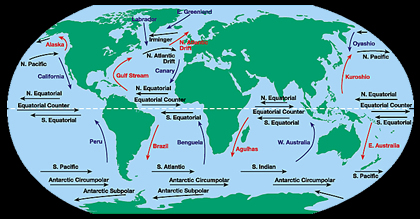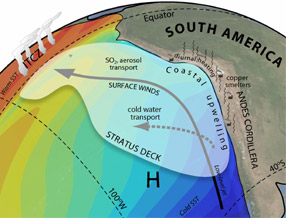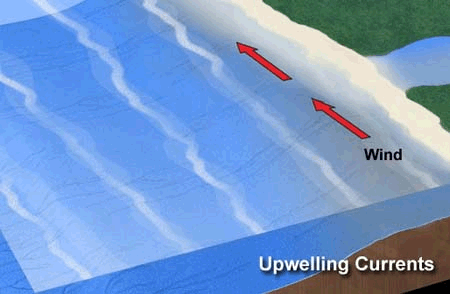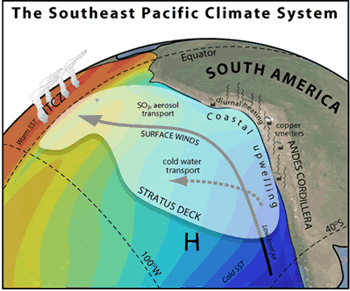At a coastal upwelling zone, wind blow parallel to a coast, water at the ocean surface moves away from the coast and deep water rises up to take its place.
Courtesy of NOAA
Ocean Upwelling
There are places in the ocean where water from the deep sea travels up to the surface. These are called areas of upwelling. The deep waters can have a large influence on marine life and the climate too.
Upwelling can happen where wind blows along a coast. The wind causes water at the ocean surface to move away from the coast. When surface water moves away from the coast, water from deeper in the ocean rises up and takes its place.
The water that is moved up to the surface is usually cold and rich in nutrients. When the deep water gets to the surface, these extra nutrients are snatched up by plankton that floats in the ocean. Tiny animals gobble up the plankton and fish eat the tiny animals. This means that upwelling areas are full of marine life.
Upwelling also happens as a part of El Niño (ENSO) events in the Pacific Ocean off the coast of Ecuador and Peru. This has an impact on weather, changing where and when rain falls in many areas of the world.
Downwelling is the opposite of upwelling - surface waters pushing down into deeper areas of the ocean. This happens when winds cause water to push toward a coast and then deeper in the ocean.
Last modified September 18, 2008 by Lisa Gardiner.
You might also be interested in:

Wind is moving air. Warm air rises, and cool air comes in to take its place. This movement creates the winds around the globe. Winds move at different speeds and have different names based on their speed.
...more
Do you like anchovies on your pizza? Many anchovies come from the Southeast Pacific Ocean near Chile and Peru. In fact, there are lots of different types of fish in this part of the world. Why are there
...more
The water at the ocean surface is moved by powerful wind. The wind is able to move the top 400 meters of the ocean. This moving water is called surface ocean currents. Surface ocean currents form large
...more
The winds in the Southeast Pacific mainly blow from south to north. They affect the weather and climate in the region. They also affect the climate in other places around the world. Air near the equator
...more
There are many connections between the ocean and the atmosphere in the Southeast Pacific Ocean. Strong winds blow north along the coast of South America. These winds stir up the ocean. That brings cold
...more
Scientists must work very hard! It will take time for them to understand the information they collected during VOCALS. They must study the measurements and use them to improve their models of clouds,
...more
There are a lot of clouds over the Southeast Pacific Ocean off the coasts of Peru and Chile in South America. In fact, this area has the largest amount of stratus and stratocumulus clouds in the world!
...more














